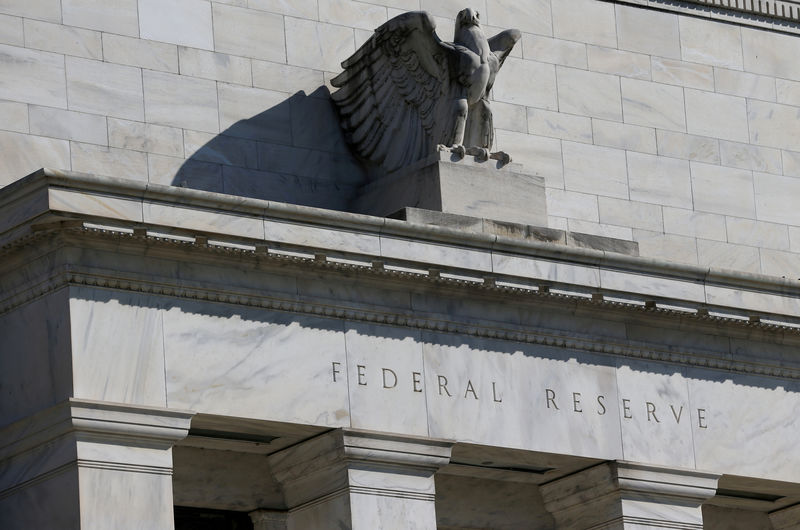By Karen Brettell
NEW YORK (Reuters) - When the U.S. Federal Reserve cut interest rates last month for the first time in more than a decade, it signaled that further reductions in borrowing costs might not be needed. Bond markets vehemently disagree.
Sliding bond yields and the inversion of a key part of the U.S. yield curve on Wednesday for the first time in 12 years show that bond investors have a far gloomier outlook for the U.S. and global economies than the U.S. central bank.
"The rates market rarely lies and globally it looks like it's expecting a day of reckoning," said Tom di Galoma, a managing director at Seaport Global Holdings in New York.
Fears are also rising the Fed may not only be behind the curve in cutting rates, but that central banks may be running out of ammunition to stimulate growth as countries offset each other's attempts to boost growth with looser fiscal policy.
Worsening economic data, weak inflationary pressures, the escalating U.S.-China trade war and intensifying tensions between protesters in Hong Kong and the Chinese government have boosted demand for safe-haven debt, sending many European government bond yields deeper into negative territory while the longest-dated U.S. Treasury yields have fallen to record lows.
The inversion of key parts of the Treasury yield curve, in which investors in short-term holdings get paid more than those in long-term ones, has historically been a reliable indicator of a coming recession.
On Wednesday, the yield on the U.S. 10-year Treasury (US10YT=RR) note tipped 2.1 basis points below 2-year Treasury yields (US2YT=RR), the first time this spread has been negative since 2007, according to Refinitiv data.
The inversion rattled investors already worried that a U.S.-China trade war might trigger a global recession and kill off a decade-long bull market on Wall Street. Major U.S. stock indexes were down about 2%.
"People are becoming more convinced that global growth is weakening and people are starting to see some signs of transmission into U.S. sentiment," said Gennadiy Goldberg, an interest rates strategist at TD Securities in New York.
"That longer-end rates are rallying does suggest some lack of confidence that the central banks will actually be able to do anything about the slowing global growth momentum," he added.
FADING OPTIMISM
At the start of the year, markets and central banks were more optimistic on the global economic outlook. The European Central Bank had just ended its stimulative bond purchase program while the Fed was seen as likely to continue hiking rates after raising borrowing costs four times in 2018.
That shifted in March, however, when the Fed abruptly brought an end to its hiking cycle. In conjunction with disappointing U.S. manufacturing data, the move sparked broad repositioning that led the 3-month/10-year yield curve to invert for the first time since 2007. That was followed in July by the Fed's first rate cut since 2008.
The U.S. central bank looks better placed to ease conditions than many of its counterparts as it still has room to cut rates. Bond markets are priced for two additional U.S. rate cuts this year and a third in the first half of next year.
The ECB, meanwhile, is evaluating cutting rates further into negative territory and undertaking another bond purchase program.
The Bank of Japan is similarly looking at lowering its negative interest rates and expanding asset purchases.
By easing financial conditions, a central bank can stimulate an economy by making business and consumer loans cheaper, while the depreciation of the local currency that results from lower interest rates can boost exports.
As central banks compete for more dovish policies, however, they threaten to cancel each other out, making each move less effective.
"The reality is that central banks around the world are responding to a diminished outlook, looking to cut rates and ease financial conditions, so basically it means the Fed's not cutting rates in a vacuum," said Jon Hill, an interest rate strategist at BMO Capital Markets in New York.
Last week, the New Zealand central bank sent investors scurrying to safe-haven currencies by cutting rates more than expected and indicating that it may take rates below zero if needed.
A chorus of other central banks including those in India, Thailand and the Philippines also cut rates during the week.
"Overburdening of monetary policy in recent years has made it almost ineffective, or even harmful in some cases, as central banks are trying to address problems beyond their control, with limited and often experimental policy tools," Bank of America Merrill Lynch (NYSE:BAC) FX strategist Athanasios Vamvakidis said in a recent report.
"We see signs that this is not a sustainable situation and may not end up well," he said.
